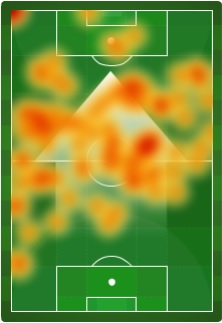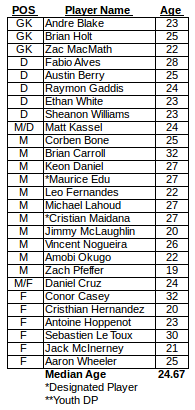Another weekend, another bunch of ones and zeroes on the scoreboards for the games I checked out. The season’s a quarter done now for just about every team, and reality is starting to set in that playoffs are only going to be a dream for some this year. Still, MLS is a league of incredible parity and almost everyone still harbors dreams of the postseason, no matter how realistic they are at the moment.
Portland Timbers 1 – 1 LA Galaxy
Stat that told the story for both teams: 2 goals, 1 uncalled red card on a breakaway in 2nd half stoppage time
It’s nearly impossible to analyze this game without spending a bulk of your attentions on second half stoppage time, when both goals were scored. Not only that, but LA’s Juninho had a breakaway chance to put the game away and was bundled over with no foul called. All in all, it was a pretty incredible conclusion to a game that was fairly entertaining, if not particularly well-played. To some degree, it was more of the same for both teams: the Galaxy struggled to finish the chances they were able to create, and Portland looked out of sorts and a little slow compared to last year’s high-octane outfit.
I want to spend a paragraph here talking a little about the apparent tactical trends of the league at the moment. For the last couple years, it seemed like the formation en vogue was the high-pressing 4-3-3: Kansas City and Portland were the most notable success stories using this setup. But this year, it appears the trend has shifted to the 4-4-2 with a diamond midfield, a la Real Salt Lake. It seems like every team in the league has at least experimented with it this year, from LA to Colorado to DC. The MLSSoccer.com March to the Match podcast did a great feature on this tactical trend a few weeks back detailing some of the pros and cons of the formation.
Anyway, this game seemed like a pretty decent case study with these two formations facing off with one another: Portland’s 4-3-3 against LA’s diamond midfield. It’s my opinion that the narrow diamond midfield does a great job of neutralizing what made the Timbers’ 4-3-3 so effective last year – that’s part of why RSL just seemed to have Caleb Porter’s number last year. Portland was at their best last year mainly because of two guys: Diego Chara and Will Johnson, who played as a double pivot and covered more ground than the Trans-Pacific Railroad. However, the Galaxy’s narrow midfield boxes that double pivot in with four central mids who are all tucked inside, limiting the number of balls Chara & Johnson can win and thereby limiting Portland’s possession. There are plenty of other reasons the Timbers haven’t been great so far this year, but it’s a trend worth watching as they try to turn their season around.
Columbus Crew 0 – 1 Vancouver Whitecaps
Stat that told the story for Columbus: 90.33% of minutes this season have been played by starting eleven
It’s no secret that Columbus started out this season like gangbusters and have since played more like busts. The reason for this is inherently simple: they only have one way of playing. Every single game from Columbus is basically the same: they play the same guys in the same roles and try the same things. It caught teams by surprise in the first few games, but now that the opposition knows what’s coming (short passes out of the back, fullbacks getting way forward, etc.) it’s gotten a lot easier to beat. And now it’s up to coach Gregg Berhalter to make some adjustments and at least give the Crew a plan B so this losing skid doesn’t continue.
Stat that told the story for Vancouver: average age of midfield and forward: 23 years old
Vancouver has sneakily been one of the surprise stories of the 2014 MLS season. Everyone knew they had a good deal of young talent on the squad, but nobody was sure how the chemistry would work out under first-year coach Carl Robinson. So far, returns have been impressive. Not only has Robinson set the team up in a position to be successful tactically, but he’s handed over a ton of responsibility to the youngsters to great effect. With veterans Kenny Miller gone and Nigel Reo-Coker perhaps on the way out, even more of the load is going to be heaped onto the 25-and-under players. During this victory, the only midfielder or forward in the starting eleven over 25 was Pedro Morales (28). And even when they made subs, they brought on 20-year-old Omar Salgado and 21-year-old Russell Teibert – I’d say the future is bright in Vancouver.
Philadelphia Union 0 – 1 DC United
Stat that told the story for DC: wide presence of the forwards
It’s interesting that a lot of season previews of DC United focused on if the wide play would be good enough to get quality service for new striker Eddie Johnson. I say this because DC has been as good, if not better, as anyone could’ve hoped, despite the presence of roughly zero wide midfielders and zero Eddie Johnson goals. There are obviously a few reasons they’ve been so good, but chiefly among them is that this is Fabian Espindola’s team. He’s played better this season than I ever remember him looking in Salt Lake as the focal point of United’s attack, orchestrating everything and creating a lot of chances. He does this by floating to the wide areas of the field to provide some width to DC’s narrow formation, as his heat map above shows (EJ’s actually pretty good at this too, particularly when holding the ball up).
Stat that told the story for Philadelphia: 647,428 times caught ball-watching this season*
Philadelphia was everyone’s darling in the first few weeks of the season. All their new acquisitions looked really impressive, they had a young and improving defense and some talent up top that was sure to start banging in the goals soon. Fast forward a couple months, and the bottom has fallen out. This loss was their ninth game without a win, they’ve switched formations like four times hoping for a spark, and their coach might get fired soon. So what’s wrong? Lots of things. But #1 in my book is simply that the Union didn’t seem that interested in playing soccer against DC this weekend. I can’t tell you how many times I’ve seen Philly midfielders or defenders or really anyone just watch an opposing player run by them or pass the ball by them with little to no contesting. And this isn’t a problem for one or two players, it’s the entire team. Sorry to be such a rah-rah coach type who says they just need to try harder, but the Union need to be more active, or engaged, or try harder….whatever wording works best.
*this is only an approximation because I couldn’t find Opta’s information on this



















